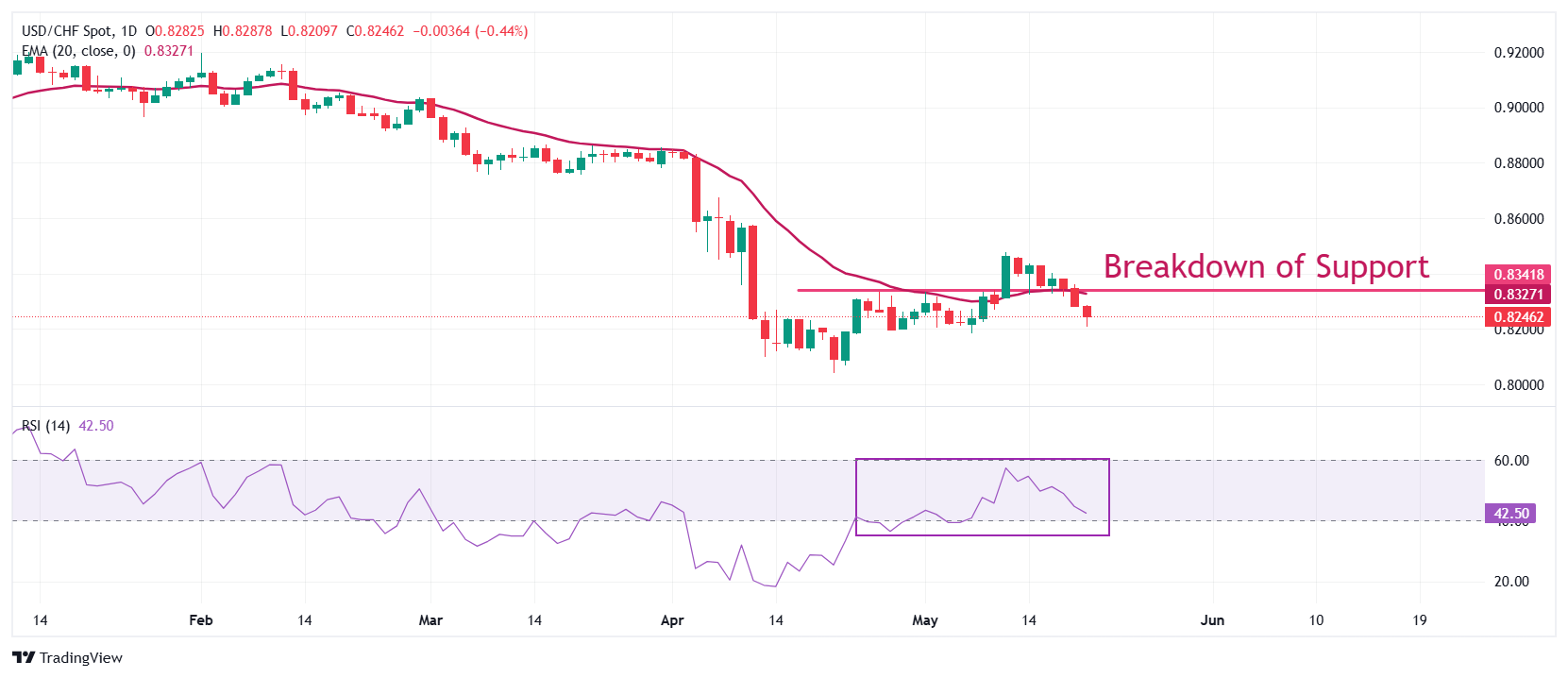USD/CHF Price Forecast: Extends losing streak for third trading day
- USD/CHF declines to near 0.8240 on continuous underperformance from the US Dollar.
- Moody’s downgraded the US Sovereign Credit rating to Aa1 on Friday.
- The SNB is open to take interest rates to the negative trajectory.
The USD/CHF pair slides to near 0.8240 during the European trading session, extending the losing streak for the third trading day on Wednesday. The Swiss Franc pair weakens as the US Dollar declines further in the wake of the United States (US) credit rating erosion after Moody’s downgraded the long-term issuer rating by one notch to Aa1 from Aaa.
The US Dollar Index (DXY), which gauges the Greenback’s value against six major currencies, slumps to near 99.50, the lowest level seen in two weeks.
Another reason behind weakness in the US Dollar on Wednesday is US President Donald Trump’s failure to convince Republicans to back the new tax-cut bill, which could increase the overall US debt by $3 trillion-$5 trillion.
On the Swiss Franc (CHF) front, investors look for fresh cues on the Swiss National Bank’s (SNB) monetary policy outlook in a light Swiss economic calendar this week. The SNB has already clarified that the central bank is open to negative interest rates on the back of potential global economic turmoil due to the imposition of tariffs by US President Donald Trump.
USD/CHF fails to gauge cushion near the monthly low of 0.8335, plotted from the April 25 low. The asset slides below the 20-day Exponential Moving Average (EMA), which trades around 0.8340, indicating that the near-term trend is bearish.
The 14-day Relative Strength Index (RSI) oscillates inside the 40.00-60.00, suggesting a volatility contraction.
Further downside below the May 7 low of 0.8186 would drag the asset towards the April 11 low of 0.8100, followed by the April 21 low of 0.8040.
On the contrary, a recovery move in the pair above the psychological level of 0.8500 will open the door for more upside towards the April 10 high of 0.8580 and the April 8 high of 0.8611.
USD/CHF daily chart

US Dollar FAQs
The US Dollar (USD) is the official currency of the United States of America, and the ‘de facto’ currency of a significant number of other countries where it is found in circulation alongside local notes. It is the most heavily traded currency in the world, accounting for over 88% of all global foreign exchange turnover, or an average of $6.6 trillion in transactions per day, according to data from 2022. Following the second world war, the USD took over from the British Pound as the world’s reserve currency. For most of its history, the US Dollar was backed by Gold, until the Bretton Woods Agreement in 1971 when the Gold Standard went away.
The most important single factor impacting on the value of the US Dollar is monetary policy, which is shaped by the Federal Reserve (Fed). The Fed has two mandates: to achieve price stability (control inflation) and foster full employment. Its primary tool to achieve these two goals is by adjusting interest rates. When prices are rising too quickly and inflation is above the Fed’s 2% target, the Fed will raise rates, which helps the USD value. When inflation falls below 2% or the Unemployment Rate is too high, the Fed may lower interest rates, which weighs on the Greenback.
In extreme situations, the Federal Reserve can also print more Dollars and enact quantitative easing (QE). QE is the process by which the Fed substantially increases the flow of credit in a stuck financial system. It is a non-standard policy measure used when credit has dried up because banks will not lend to each other (out of the fear of counterparty default). It is a last resort when simply lowering interest rates is unlikely to achieve the necessary result. It was the Fed’s weapon of choice to combat the credit crunch that occurred during the Great Financial Crisis in 2008. It involves the Fed printing more Dollars and using them to buy US government bonds predominantly from financial institutions. QE usually leads to a weaker US Dollar.
Quantitative tightening (QT) is the reverse process whereby the Federal Reserve stops buying bonds from financial institutions and does not reinvest the principal from the bonds it holds maturing in new purchases. It is usually positive for the US Dollar.


